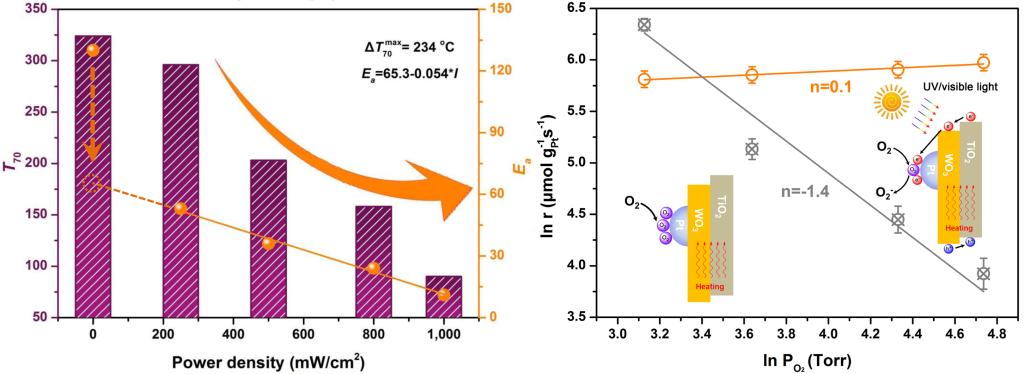A progress in photo-thermo catalytic oxidation reaction
Author:KANG Lei Date:2020年04月09日 17:12 Click:
A research group led by Prof. LIU Xiao Yan and Prof. ZHANG Tao from the Dalian Institute of Chemical Physics (DICP) of the Chinese Academy of Sciences proposed a strategy of photo-thermo catalysis to overcome the oxygen poisoning of supported platinum catalyst in oxidation reaction. The results were published in Angew. Chem. Int. Ed. On Apr. 5.

Influences of light irradiation on T70, Ea, and reaction order of O2. (Image by KANG Lei)
Catalytic oxidation reaction using molecular oxygen as the oxidant is industrially important. Supported platinum is one of the most active catalysts for this kind of reactions. Distinct from the CO poisoning in CO oxidation, the active Pt sites on the surface of the catalysts can be easily poisoned by oxygen in most of the oxidation reactions. For instance, the activity of supported Pt catalysts drops sharply with the augment of O2/propane (C3H8) ratios, which is a pervasive problem in supported platinum group metal (PGM) catalysts for hydrocarbon oxidation.
The photo-thermo catalysis of semiconductor-supported Pt catalyst (Pt/TiO2-WO3) was found to be capable of dramatically enhancing the catalytic oxidation of C3H8 at low temperatures and high O2/C3H8 ratio (volume ratio: 20). With the irradiation of ultraviolet-visible light, the reaction temperature for 70 % C3H8 conversion (T70) decreased from 324 oC to 90 oC, correspondingly, the apparent activation energy (Ea) reduced more than ten times. The reaction order (n) of the reactants changed sharply, especially for the O2 increased from -1.4 to 0.1. This study not only overcome the oxygen poisoning of the Pt catalyst, but also provided an in-depth insight into the photo-thermo catalysis of the semiconductor supported nonplasmonic metal catalysts.
This work was supported by the National Key R&D Program of China, the Strategic Priority Research Program of the Chinese Academy of Sciences, the National Natural Science Foundation of China and the China Postdoctoral Science Foundation. (Text by KANG Lei)